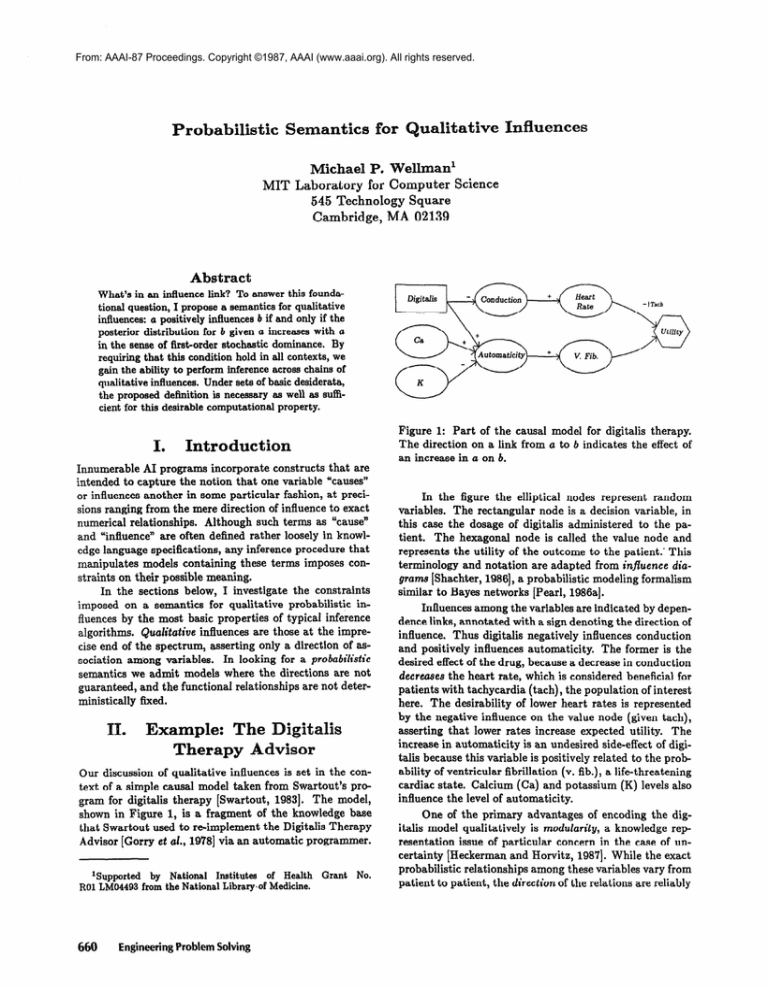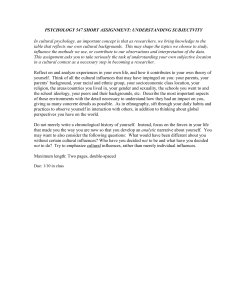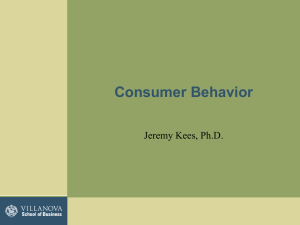
From: AAAI-87 Proceedings. Copyright ©1987, AAAI (www.aaai.org). All rights reserved.
Robabilistic
Semantics
ualitative
Influences
Michael P. Wellman
MIT Laboratory
for Computer Science
545 Technology Square
Cambridge, MA 02139
Abstract
What’s in an infiuence link? To answer this foundational question, I propose a semantics for qualitative
influences: a positively influences b if and only if the
posterior distribution for b given o increases with o
in the sense of first-order stochastic dominance. By
requiring that this condition hold in all contexts, we
gain the ability to perform inference across chains of
qualitative influences. Under sets of basic desiderata,
the proposed definition is necessary as well as sufF~cient for this desirable computational property.
I,
Introduction
Innumerable AI programs incorporate constructs that are
intended to capture the notion that one variable “causes”
or influences another in some particular fashion, at precisions ranging from the mere direction of influence to exact
numerical relationships. Although such terms as “cause”
and “influence” are often defined rather loosely in knowledge language specifications, any inference procedure that
manipulates models containing these terms imposes constraints on their possible meaning.
In the sections below, I investigate the constraints
imposed on a semantics for qualitative probabilistic influences by the most basic properties of typical inference
algorithms. Qualitative influences are those at the imprecise end of the spectrum, asserting only a direction of association among variables. In looking for a probabilistic
semantics we admit models where the directions are not
guaranteed, and the functional relationships are not deterministically fixed.
HI,
Example:
The
Therapy Advisor
Cur discussion of qualitative influences is set in the context of a simple causal model taken from Swartout’s program for digitalis therapy [Swartout, 19831. The model,
shown in Figure 1, is a fragment of the knowledge base
that Swartout used to re-implement the Digitalis Therapy
Advisor [Gerry et al., 19781 via an automatic programmer.
‘Supported by National Institutes of Health Grant
ROl LM04493 from the National Library-of Medicine.
660
EngineeringProblem Solving
No.
Figure 1: Part of the causal model for digitalis therapy.
The direction on a link from a to b indicates the effect of
an increase in a on b.
In the figure the elliptical nodes represent random
variables. The rectangular node is a decision variable, in
this case the dosage of digitalis administered to the patient. The hexagonal node is called the value node and
represents the utility of the outcome to the patient.’ This
terminology and notation are adapted from influence diagram [Shachter, 19861, a probabilistic modeling formalism
similar to Bayes networks [Pearl, 1986a].
Influences among the variables are indicated by dependence links, annotated with a sign denoting the direction of
influence. Thus digitalis negatively influences conduction
and positively influences automaticity. The former is the
desired effect of the drug, because a decrease in conduction
decreases the heart rate, which is considered beneficial for
patients with tachycardia (tach), the population of interest
here. The desirability of lower heart rates is represented
by the negative influence on the value node (given tach),
asserting that lower rates increase expected utility. The
increase in automaticity is an undesired side-effect of digitalis because this variable is positively related to the probability of ventricular fibrillation (v. fib.), a life-threatening
cardiac state. Calcium (Ca) and potassium (K) levels also
influence the level of automaticity.
One of the primary advantages of encoding the digitalis model qualitatively is modularity, a knowledge representation issue of particular concern in the case of uncertainty [Heckerman and Horvitz, 19871. While the exact
probabilistic relationships among these variables vary from
patient to patient, the direction of the relations are reliably
taken as constant. Conclusions drawn from this model are
therefore valid for a much broader class of patients.
The conclusions we would like our programs to derive
from the digitalis model are those taken for granted in the
description above. For example, we unthinkingly assumed
that the effects of digitalis on conduction and of conduction on heart rate would combine to imply that digitalis
reduces the heart rate. Further, because lower heart rates
are desirable, digitalis is therapeutic along the upper path.
Similarly, it is toxic along its lower path to the value node.
The tradeoff between therapy and toxicity cannot be resolved by the mere qualitative influences in the model.
The remainder of this paper develops a semantics for
qualitative influences that justifies the kinds of inferences
we require while providing the maximum possible degree of
modularity. A formalism for qualitative influences among
binary events was introduced in a previous paper [Wellman, 19871. In the sections below I present the basic definitions, extending them to cover multi-valued parameters.
The resulting definition is shown to be the weakest that
satisfies our inference desiderata.
Consider two random variables, a and b. Informally, when
a and 6 are dichotomous events, a qualitative influence is
a statement of the form “a makes b more (or less) likely.”
This binary case is easy to capture in a probabilistic assertion. Let A and A denote the assertions a = true and
a = false, respectively, and similarly, B and B. Then
we say “a positively influences b,” written S+(a, b), if and
only if
Vx Pr(.B]Ax) 2 Pr(B]Az).
(1)
In the equation x ranges over all assignments to the other
event variables consistent with both A and A. The quantification is necessary to assert that the influence holds in
all contexts, not just marginally. Because of this context
variable, S+ holds in a particular influence network programs that alter the structure of the network may exhibit
non-monotonicity in S+ [Grosof, 19871. Conditions analogous to (1) and those following serve to define negative
and zero influences, omitted here for brevity.
For the dichotomous case, Bayes’s rule implies that (1)
is equivalent to
Vx Pr(A]Bx)
2 Pr(A]Bx).
(2)
In the terminology of Bayesian revision (1) is a condition
on posteriors, while (2) is a condition on likelihoods. Notice
that S+(a, b) is simply an assertion that the likelihood ratio
is greater than or equal to unity.
Formalizing S+ is not quite so straightforward when a
and b take on more than two values. In such cases we want
to capture the idea that “higher values of a make higher
values of b more likely.” An obvious prerequisite for such
statements is some interpretation of “higher.” Therefore,
we require that each random variable be associated with
an order 2 on its values. For numeric variables such as
Upotassium concentration,n this relation has the usual interpretation; for variables like “automaticity” a measurement scale and ordering relation must be contrived.
The more troublesome part of defining positive influences is in specifying what it means to Qmakehigher values
of b more likely.” Intuitively, we want a statement that the
probability distribution for b shifts toward higher values
as a increases. To make such a statement, we need an ordering that, given any two cumulative probability density
functions (CDFs) Gi and G2 over b, determines whether
Gr is “higher” than 62.
However, not all probability distributions can be easily ordered according to the size of the random variable.
Different rankings are obtained through comparing distributions by median, mean, or mean-log, for example.
We require an ordering that is robust to changes of these
measures because the random variables need be described
by merely ordinal scales [Krantz et al., 19711. An assertion that calcium concentration positively influences automaticity should hold whether calcium is measured on an
absolute or logarithmic scale, and regardless of how automaticity is measured.
An ordering criterion with the robustness we desire
is first-order stochastic dominance (FSD) [Whitmore and
Findlay, 19781. FSD holds for Gr over Gz if and only if
the mean of Gr is greater than the mean of G2 for any
monotonic transform of b. That is, for all monotonically
increasing functions 4,
/
W)G(b)
2
J
cb(+G@).
(3)
A necessary and sufficient condition for (3) is
Vbcl(b) 5
(4
G2(b).
That is, for any given value of b the probability of obtaining
b or less is smaller for Gi than for G2. For further discussion and a proof that (4) is equivalent to (3), see (Fishburn
and Vickson, 19781.
We are now ready to define qualitative influences. Let
F(b(aix) be the CDF for b given a = ai and context x.~
Then S+(a, b) if and only if
Val, a2, x
a1 2 a2 +
F(bla,x)
FSD F(blaax).
(5)
Adopting the convention for binary events that true >
false, we can verify that (5) is a generalization of (1).
Like (I), (5) is a condition on posteriors.
Milgrom [Milgrom, 19811 proves that the equivalent likelihood condition is the Monotone Likelihood Ratio Property
(MLRP) from statistics [Berger, 19851.
aAs above, z ie an assignmentto the remainingrandomvariables
consistent with the condition as = ~6. We need to include x here
and in the definitions below becausetheseconditionswill be applied
in situations where z is partially or totally known. If we had stated
the conditions in marginal terms (“on average, a positively influences
b-1, it would not be valid to apply them in specific contexts.
Finally, we need a special definition for influences on
the value node. The variable a positively influences utility,
U+ (a), if and only if
va,a2,x
a1 L a2 =+ +l,s)
3 +2,x),
(6)
where u is a utility function [Savage, 19721 defined over the
event space.
Because b positively influences c, the pointwise FSD condition (4) implies that for any co, G(co ]bzo) is a decreasirag
over
function of b. And S+(a, b) entails FSD of F(blqxo)
F(blazx,-,). Therefore, (3) applies with the inequality reversed (negating G(colbxo) yields an increasing function),
leading to the conclusion
Vco
IV.
Chains of Pnfluence
In an earlier paper on qualitative influences [Wellman,
19871, I considered networks of variables connected by influence links describing the direction of probabilistic dependence. There, I demonstrated for the binary case that,
in the absence of direct links from a to b, S+(u, b) A
S+(b,c) =% S+(u,c).
From a computational perspective
the ability to perform inference across influence chains is
an essential property of a qualitative algebra. From the
digitalis model, for example, we would like to deduce that
increasing the dose of digitalis decreases the heart rate but
increases the likelihood of v. fib. Indeed, most programs
with models like this would make such an inference. Fortunately, the definition offered above for S+ implies transitivity for multi-valued as well as binary variables.
Proposition
1 If a and c are not connected by any direct
links, S+(a, b), and S+(b,c),
then S+(a,c)
holds in the
network obtained by removing b.
Proof: Choose al and a2 such that al > ~2, and an so
consistent with al, ~2, and all b. Let G denote the conditional CDF for c and c the minimal value of the variable.
By the definition of cumulative probability we have
G(coluixo) = 1”
E
/
fac(bcluixo)dbdc.
Changing the order of integration and decomposing
joint probability yields
G(colwo)
=
//
cco f,(claibxo)fa(blaizo)dcdb.
(7)
the
(8)
Because a and c are conditionally independent given b and
5, we can remove ui from the fc expression.3 Rewriting
the density function as the derivative of a cumulative, we
get
G(cola2~0),
(11)
implying FSD. Because al) a2, and zro were chosen arbitrarily, we have finally S+(u, c).
Similar arguments with the appropriate signs and directions switched would reveal that chains of influences
may be combined by sign multiplication.
In the remainder of this section I present some simple
desiderata for a qualitative influence definition that entail
the hecessity of FSD for chaining influences. We start by
specifying the form such definitions must take. To capture
the intent of “higher values of a make higher values of b
more likely” in a probabilistic semantics, it seems reasonable to restrict our attention to conditions on the posterior
distribution of b for increasing values of a. Therefore, we
postulate that a definition of S+(u, b) must be of the form
02)
where R is some relation on CDFs. This condition is exactly (5) with FSD replaced by the more abstract relation.
There are two basic desiderata that severely restrict
the possible Rs. First, the definition for S+ induced by
R in (12) must satisfy Proposition 1. Without the ability
to chain inferences, the qualitative influence formalism has
little computational value. Second, the condition must be
a generalization of the original definition of S+ for dichotomous events (1). With only two possible values there does
not appear to be a weaker monotonicity condition. These
criteria lead to a sharp conclusion.
Proposition 2 Let @(a,
following conditions:
b) be defined by (121. Given the
1. Proposition 1
2. For binary b, al 2 ~2, and x,
F(blalx)
R F(blu2x)
ts Pr(B]ars)
2 Pr(BIa2z)
(13)
the weakest R is FSD.
G(colwo)
fc(clbxo)dcdF(bluixo).
=
(9)
The inner integral is simply the CDF for c given b.
G(colwo)
=
/
G(coIbxo)dJ’(blaixo).
(10)
SThe conditional independence follows from separation in the influence network. See Pearl [Pearl, 1986b] for a discussion of the
independence properties of graphical probability representations.
662
G(coJwo)I
EngineeringProblem Solving
Proof: First, note that FSD satisfies these conditions.
Next, assume that R satisfies them but R does not entail FSD. We will start with an instantiation of Proposition 1 and derive a contradiction. Let a, b, and c be the
only variables (so we can safely ignore x) with S+(a, b),
S+(b, c), and no other direct links. For concreteness, let
b range over the unit interval [0, l] and c be binary with
Pr(C]b) = 4(b), for some 4 : [0, l] -+ [0, l] monotonic. The
monotonicity of 4 guarantees S+(b, c): By assumption,
Proposition 1 applies, yielding the conclusion Sf (a, c) and
therefore F(c]ar) R F(cJa2). Because c is binary, (13) must
hold. Expanding the expression for the posterior probability of c given a, the RBS of (13) becomes
/,’ 4(b)dJ’(blal)
2 /,’ 4(bW’(blw).
(14
Because 4 may be any monotonic function, FSD is necessary for (14) and is therefore entailed by R.
The force of this result is weakened somewhat by
the u priori restriction of definitions to those having the
form of (12). Many statistical concepts of directional relation (based on correlation or joint expectations, for example) do not fit (12) yet appear to be plausible candidates
for a definition of qualitative influence. Quadrant dependence [Lehmann, 19661 holds between a and b when4
Vul,a2
al 2 u2 =+ F(blu 5 al) FSD F(bla 5 ~2).
U+(u) is satisfied in the reduced network if and only if
u(ai, z) is increasing in ui. From (6) we know that u(b, 5)
is monotonically increasing in b. In fact, it can be any
monotonic function. Therefore, (16) is increasing in ai
under the same conditions as (3), which is exactly S+ as
defined by (5).
Proposition 3 demonstrates that while conditions. like
quadrant dependence which are weaker than Sf may be
sufficient for propagating influences across chains, they are
not adequate to justify decisions across chains. For choosing among alternatives, the relevant parameter is the utility function evaluated at a point; utilities conditioned on
intervals of the decision variable (as in quadrant dependence) do not have the same decision-making import.
(15)
Lehmann proves that quadrant dependence is necessary
but not sufficient for regression dependence, which is his
terminology for (5) without the quantification over contexts z. As quadrant dependence is weaker yet still exhibits transitivity, 6 it seems to be an attractive alternate
to regression dependence. To justify our choice of the latter, we must appeal to the decision-making implications of
probabilistic models.
The prime motivation for adopting a probabilistic semantics is so that the behavior of our programs can be justified
by Bayesian decision theory [Savage, 19721. A decision is
valid with respect to an influence model if expected utility is maximized. For example, if U+(u) and there are no
indirect paths from a to the value node, then a decision of
al over a2 is valid if and only if al > a2, by the definition
of U+ (6).6 Decision-making power is enhanced if we can
deduce new influences on utility from chains of influences
in the network. Our definition of qualitative influence is
necessary as well as sufficient for such inferences.
Proposition 3 Consider a network where W+(b) holds
and a and u are not connected by any direct links. A necessary and suficient condition fir U+(a) on removal of b
is S+ (a, b) as defined by (5).
The basic definitions above can be extended in a variety
of ways. Conditional influences-defined for binary events
in a previous paper [Wellman, 1987]-simply
delimit the
range of z in (5). For example, the negative influence of
heart rate on utility in the digitalis model is conditional
on tachycardia.
Swartout’s XPLAIN knowledge base included the “domain principle” that if a state variable acts synergistically
with the drug to induce toxicity, then smaller doses should
be given for higher observations of the variable [Swartout,
19831. This fact could be derived by a domain-independent
inference procedure given a suitable definition for qualitative synergy. We can say that two variables synergistically influence a third if their joint influence is greater (in
the sense of FSD) than separate statistically independent
influences.’ In the digitalis example, we need to assert
that digitalis acts at least independently with Ca and K
deviations in increasing automaticity. In addition, we must
specify that the decrease in utility for a given increase in
automaticity is larger when automaticity is already high.
Such a relationship can be captured by an assertion that
automaticity is synergistic with itself in its toxic effects.
elated
“The existence of other paths from a to utility would leave open
the possibility that the net influence of a is negative. For exam-
Philosophers have long attempted to develop mathematical definitions of causality. Motivated by computational
rather than philosophical concerns, I have ignored in this
treatment temporal properties, mechanisms, spuriousness,
and other issues salient to causality. These concerns aside,
Suppes [Suppes, 19701 proposes a probabilistic condition
equivalent to (1) without the context quantification for binary events. For multi-valued variables, Suppes suggests
quadrant dependence (15).
As suggested previously, ordering of random variables has also attracted considerable interest in statistics [Berger, 1985, Lehmann, 1966, Ross, 19831 and decision theory [Whitmore and Findlay, 19781. Milgrom [Mil-
conduction and heart rate as a direct positive influence. But this
might be outweighed by the indirect negative influence of digitalis
via automaticity.
7This type of relationship was exploited by NESTOR [Cooper,
19841, a diagnostic program based on probabilistic inequalities.
Proof: The expected utility of ai with any x is given by
u(a&x)
=J u(b, z)dF(bluiz).
(16)
‘This ia actually the condition Lehmann proposes as a strengthening of quadrant dependence. The basic quadrant dependence fixes
01 at a’s maximal value.
6For transitivity we need to quantify over contexts in (15). The
proof parallels that for Proposition 1.
ple, we could summarizethe therapeuticeffect of digitalisthrough
Wellman
663
grom, 19811 demonstrates the application of MLRP to theoretical problems in informational economics.
The key difference between the S+ definition proposed
here and previous work is that we obtain transitivity by requiring the condition to hold in all contexts. Suppes shows
that the causal algebra induced by his condition-defined
only at the margin-does
not possess the transitive property. As argued above, this is a computationally essential
characteristic of qualitative influences.
VIII.
Conclusions
Despite the ubiquity of qualitative influence assertions in
knowledge representation mechanisms, there has been little study of the semantics of such constructs. Previous
work either denies the probabilistic nature of the relationships among variables in the model or takes for granted
the ability to draw inferences by chaining influences in the
network. I have defZned a positive qualitative influence
of a on b as an assertion that, in all contexts, the posterior probability distribution for b given a is stochastically
increasing (FSD) in a. A series of propositions provided
theoretical support for this S+ definition:
Q s+
supports chaining of influences.
is the weakest posterior condition that supports
chaining of influences.
0 s+
is necessary and sufficient for chaining decisions
across influences.
0 s+
A semantics for qualitative influences should prove
valuable for analyzing knowledge bases like the digitalis
model of Figure 1, as well as knowledge representation
theories that include similar constructs.
In particular,
the definition of S+ can help to evaluate the potential of
purely qualitative methods like Cohen’s endorsement approach [Cohen, 19851and to characterize the techniques
from AI work on qualitative reasoning that are valid in
probabilistic domains.
Acknowledgments
Zak Kohane, Bill Long, Ramesh Patil, Elisha Sacks, Kate
Unrath, and Alex Yeh positively influenced this paper.
References
[Berger, 19851 James 0. Berger. Statistical Decision Theory and Bayesian Analysis. Springer-Verlag, second
edition, 1985.
[Cohen, 19851Paul R. Cohen. Heuristic Reasoning about
Uncertainty:
An Artificial Intelligence Approach.
Volume 2 of Research Notes in Artificial Intelligence,
Pitman, 1985.
[Cooper, 19841 Gregory Floyd Cooper.
MESTOR:
A
computer-based medical diugnastic aid that integrates
causal und probabilistic knowledge. PhD thesis, Stanford University, November 1984.
664
Engineering Problem Solving
[Fishburn and Vickson, 19781 Peter C. Fishburn and Raymond G. Vickson. Theoretical foundations of stochastic dominance. In [Whitmore and Findlay, 19781.
[Gerry et al., 19781G. Anthony Gorry, Howard Silverman, and Stephen 6. Pauker. Capturing clinical expertise: A computer program that considers clinical
responses to digitalis. American Journal of Medicine,
64:452-460, March 1978.
[Grosof, 19871 B enj amin N. Grosof. Non-monotonicity in
probabilistic reasoning. In John F. Lemmer, editor,
Uncertainty in Artificial Intelligence, North-Holland,
1987.
[Heckerman and Horvitz, 19871 David E. Heckerman and
Eric J. Horvitz. The myth of modularity in rule-based
systems. In John F. Lemmer, editor, Uncertainty in
Artificial Intelligence, North-Holland, 1987.
[Krantz et al., 19711David H. Krantz, R. Duncan Lute,
Patrick Suppes, et al. Foundations of Measurement.
Academic Press, New York, 1971.
[Lehmann, 19661 E. L. Lehmann. Some concepts of dependence. Annals of Mzthemata‘cal Statistics, 37:1137-
1153,1966.
[Milgrom, 19811 Paul R. Milgrom. Good news and bad
news: Representation theorems and applications.
Bell Journal of Economics, 12:380-391,
1981.
[Pearl, 1986a] Judea Pearl.
Fusion, propagation, and
structuring in belief networks. Artificial Intelligence,
29:241-288,
1986.
[Pearl, 1986b] Judea Pearl. Murkow and Buyes networks:
A comparison of two graphical representations of probabilistic knowledge. Technical Report R-46, UCLA
Computer Science Department, September 1986.
[Ross, 19831Sheldon M. Ross. Stochastic Processes. John
Wiley and Sons, 1983.
[Savage, 19721 L eonard J. Savage. The Foundations of
Statistics. Dover Publications, New York, second edition, 1972.
[Shachter, 19861 Ross D. Shachter. Evaluating influence
diagrams. Operations Research, 34, 1986.
[Suppes, 19701 Patrick Suppes. A Probabilistic Theory of
Causality. North-Holland Publishing Co., Amsterdam, 1970.
[Swartout, 19831 William R. Swartout. XPLAIN: A system for creating and explaining expert consulting programs. Artificial Intelligence, 21:285-325,
1983.
[Wellman, 19871 Michael P. Wellman. Qualitative probabilistic networks for planning under uncertainty. In
John F. Lemmer, editor, Uncertainty in Arta’ficiul Intelligence, North-Holland, 1987.
[Whitmore and Findlay, 19781 G. A. Whitmore and M. C.
Stochastic Dominance:
An ApFindlay, editors.
proach to Decision Making Under Risk. D. C. Heath
and Company, Lexington, MA, 1978.




